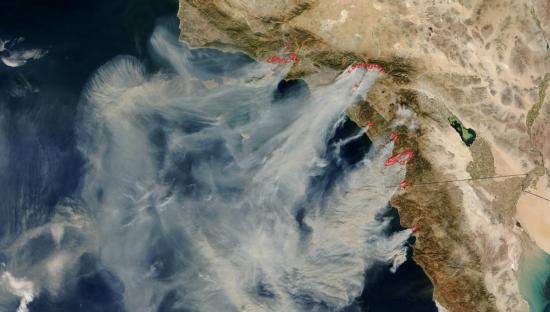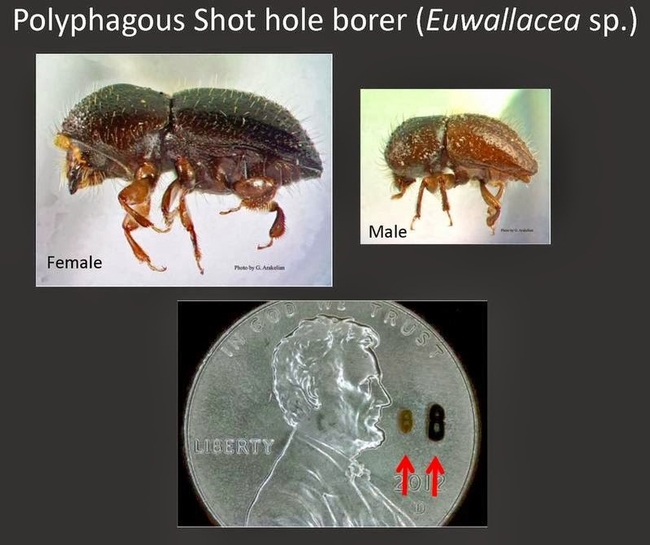
Posts Tagged: san diego
Polyphagous Shot Hole Borer: San Diego Population Now Known as Kuroshio Shot Hole Borer
Through DNA sequencing, UCR entomologist have determined that we have two separate invasions of the Polyphagous Shot Hole Borer (PSHB) here in southern California attacking avocados. One invasion in San Diego County and the second in Los Angeles County. UCR entomologist, Richard Stouthamer states the two are different species genetically, but morphologically they are indistinguishable, luckily they both respond to the same lure. They do however carry different fungal symbionts with them.
The species that has invaded San Diego, is now known as the Kuroshio shot hole borer, and is originally found only in two places in the presumed native range: highlands of Taiwan and in Okinawa. The species of beetle that has invaded Los Angeles County will now be known solely as the Polyphagous, its native range is in Vietnam, South China, North Thailand, low lands of Taiwan and Okinawa, this species has also invaded Israel and South Africa.
These Shot Hole Bores are Ambrosia beetles, a specialized group belonging to the family Scolytidae. The shot hole borer was first found in Whittier Narrows in Los Angeles County in 2003. From 2003-2010 the beetle was found on a few ornamental trees, then in 2010 it was the presumptive cause of the death of a large number of box elder street trees in Long Beach. In 2012 the beetle was collected from a backyard avocado tree in South Gate, and from several tree species at local botanical gardens, since then it has been causing havoc in the avocado industry. It now appears to be established in Los Angeles, Orange, San Bernardino and Riverside Counties, and is expanding its range in San Diego County. A single beetle was caught in Santa Cruz County in 2014 and has now been found less than 2 miles from Ventura County line.
The beetle is dark brown to black and tiny, with females between 0.07 and 0.1 inches long, and males even smaller, usually about 0.05 inches long. They differ from the bark beetles in this family in several ways. While bark beetles burrow in the phloem layer or at the juncture of the bark and sapwood, ambrosia beetles bore through the bark and into the sapwood. The shot hole bores are highly specialized and feed on fungi that they cultivate on the walls of the tunnels. In the case of the shot hole bores, they transport the pathogenic fungus, Fusarium euwallacea and both the adults and larvae feed on the fungus.
Shot hole borers attacks hundreds of tree species, but it can only successfully lay its eggs and/or grow the fungi in certain hosts. These include: Avocado, Box elder, California sycamore, Coast live oak, White alder, Japanese maple, and Red willow. Visit http://eskalenlab.ucr.edu/ for the full list. Infection with the fungus can cause a dry or wet and oily dark stain surrounding the entry holes, discolored wood, leaf discoloration and wilting, and dieback of entire branches. In box elders and avocados, a while crusty ring of sugar, also called a “sugar volcano” can be produced. Frass (wood dust left behind from boring) may be produced, but because this can quickly dissolve if it rains it can be missed sometimes. If the barked is scraped away, dark dead tissue may be found around the galleries.
Currently there is no cure for the fungus once the tree has become infected. Chipping and solarizing/tarping infested wood can help to limit the spread of the beetle/fungus. Wood should be chipped to pieces smaller than 1". Don't forget to sterilize pruning tools between uses to avoid spreading the fungus.
If you suspect you may have the shot hole bore in your grove please feel free to contact your local CE Farm Advisor/Specialist.
Avocado Meetings
California Avocado Growers Seminar Series 2013
“New and Important Tools For Avocado…”
Presented by:
California Avocado Society, Inc.
California Avocado Commission
University of California Cooperative Extension
******************************************************************
**February Seminar: Harvesting Strategies, Post-Harvest Handling, and H2A Updates
February 5th (Tuesday): San Luis Obispo (1-3 PM) Cooperative Extension Office/ Auditorium, 2156 Sierra Way, San Luis Obispo
February 6th (Wednesday): Ventura (9-11 AM) Ventura Government Center/Lower Plaza Assembly Room, 800 South Victoria Ave, Ventura
February 7th (Thursday) Temecula (9-11 AM) Temecula Civic Center, 41000 Main Street, Temecula
******************************************************************
**April Seminar: Chemical Strategies and Pest Updates
April 2nd (Tuesday): San Luis Obispo (1 - 3 PM) Cooperative Extension Office/ Auditorium, 2156 Sierra Way, San Luis Obispo
April 3rd (Wednesday): Ventura (9 - 11 AM) Cooperative Extension County Office/Conference Room, 669 County Square Drive, Ventura
April 4th (Thursday): Temecula (9 - 11 AM) Temecula Civic Center, 41000 Main Street, Temecula
******************************************************************
**June Outdoor Seminar: Field Fertilization and Herbicide Uses
June 4th (Tuesday): San Luis Obispo (1 - 3 PM) Location TBA
June 5th (Wednesday): Ventura (9 - 11 AM) Location TBA
June 6th (Thursday): Temecula (9 - 11 AM) Location TBA
******************************************************************
**August Seminar: Fertilization Techniques, PGR’s, and Local Issues Updates
August 6th (Tuesday): San Luis Obispo (1-3 PM) Cooperative Extension Office/ Auditorium, 2156 Sierra Way, San Luis Obispo
August 7th (Wednesday): Ventura (9 - 11 AM) Cooperative Extension County Office/Conference Room, 669 County Square Drive, Ventura
August 8th (Thursday): Temecula (9 - 11 AM) Temecula Civic Center, 41000 Main Street, Temecula
******************************************************************
**PCA Hours are pending
Project 8
The California Avocado Society (CAS) has received a grant from the USDA to conduct a seminar series in Spanish on avocado production. The program is focused on providing training on the basics of growing avocados, including irrigation, fertilization, pruning, harvesting, pest management, GAP in avocados, tool maintenance, etc. To give this program an easy to use name, it is simply referred to as Project 8.
The series is aimed primarily at workers who provide services other than harvesting and can increase their productivity through improving their understanding of the avocado growing system. The seminars are open to anyone, however CAS especially wants to reach those who work for small growers and provide the majority of the cultural operations for the grove.
Each seminar will be given completely in Spanish by native Spanish speakers. The seminar will include an expert in the subject from the University or similar institution and a person who has extensive field experience in the subject to give a practical perspective on the topic and how it applies to the worker’s every day work environment.
All participants will receive a certificate of completion to show that they have attended that particular course in the series.

avocado
Wildfire season is upon us
I’m from San Diego. We don’t get a whole lot of extreme weather in San Diego. My comfortable temperature tends to range from 70 to 80 degrees. We don’t get snow, no hurricanes, no tornadoes. But we do get the Santa Anas—hot dry winds blowing out of the desert. Which means we get wildfires. I’m fairly familiar with wildfires. So much so, that I once mistook snow falling from the sky for ash falling from the sky. (Like I said, I’m from Southern California).

Our last big fires were in 2007, when half a million people were evacuated from their homes, including myself. It was a scary time. In San Diego, we were surrounded. There were fires to the north, east and south of us, and the ocean to our west. There was no way out. So much of Southern California was up in smoke, satellite images made it look like the entire bottom half of our state was burning. For weeks after, we walked around wearing masks as the winds tried to make up their minds about which way to blow the smoke. At the time I worked for a social service program with a fairly robust wildfire recovery program, and I saw firsthand the damage the fires had caused for so many families.
Now, five years later, wildfire season is once again upon us, and conditions aren’t looking so good. California rainfall was below-average this year, causing our vegetation to dry out sooner than expected. When you mix that with the high temperatures being predicted for this summer, the threat for fire danger is high. The National Oceanic and Atmospheric Administration has already started putting out critical fire weather headlines for Southern California, and elsewhere in the southwest.
Help mitigate this fire season by making sure you’re prepared. UC Agriculture and Natural Resources has a wealth of information to help you mitigate the wildfire potential in your area and keep your home safe. The Homeowner’s Wildfire Mitigation Guide, The Combustibility of Landscape Mulches and Fire Information Engine Toolkit compiled by scientists from UC Cooperative Extension and UC Berkeley are great resources for homeowners in fire-prone areas. The information will help you understand how houses ignite and what to look for when fire-proofing your home this season.
Landowners living in the wildland urban interface will find this S.A.F.E. Landscapes Southern California Guidebook useful for creating fire safe landscapes to help protect their homes. Likewise,Wildfire Zone, a collaboration between University of California Cooperative Extension and the County of San Diego, offers tips for reducing the risks and hazards of wildfires both in English and Spanish. More resources can also be found in the ANR Catalog.
Smokey says “Only you can prevent forest fires.” He’s right. Do your part, and make sure you’re prepared this wildfire season.


